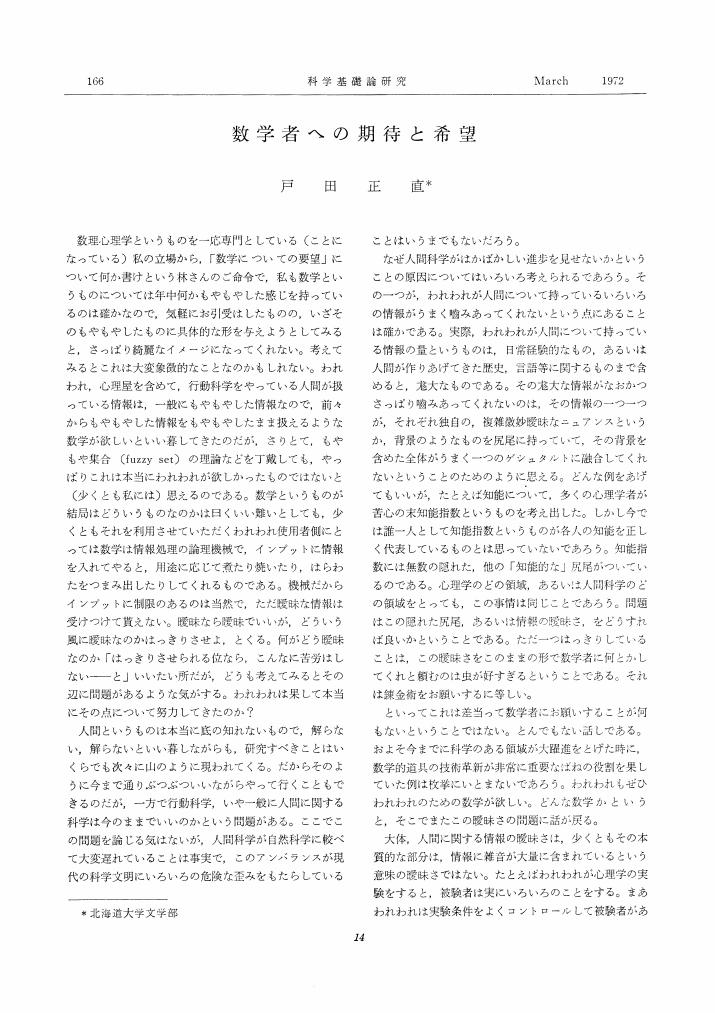9 0 0 0 OA アージ理論の計算モデル的側面
- 著者
- 戸田 正直
- 出版者
- 日本認知科学会
- 雑誌
- 認知科学 (ISSN:13417924)
- 巻号頁・発行日
- vol.1, no.2, pp.2_31-2_41, 1994-11-30 (Released:2008-10-03)
- 参考文献数
- 24
The urge theory, that has been developed by the author, intends to achieve a comprehensive model of human emotion, cognition, and individual and social behaviors. Any model that pursues as remote a goal as this has to employ, as a means to its verification, computational formalizations of whatever parts of the theory that allow them. In this paper, a few possibilities of such partial computational formalization are demonstrated, even though none of them is hardly complete as yet.The urge theory starts with an explication of emotions. Because of the inherent ambiguity of the everyday notion of emotions, the theroy introduces three basic concepts of its own: urge activity plan, mood-state, and emotional attitude. The major content of this paper consists of, first laying foundational remarks on these three major concepts, and then going on somewhat more in detail to discuss appraisal, attention and the structure of the urge activity plan. With this last topic, a new concept, the versatile system structure, an elaboration of the idea used by Minsky in his Society of the Mind model, is introduced.
7 0 0 0 OA 感情システムと認知システム:アージ理論の立場から
- 著者
- 戸田 正直
- 出版者
- 日本認知心理学会
- 雑誌
- 認知心理学研究 (ISSN:13487264)
- 巻号頁・発行日
- vol.3, no.2, pp.205-215, 2006-03-31 (Released:2010-10-13)
- 参考文献数
- 9
- 被引用文献数
- 2
筆者が開発してきたアージ理論を,感情システムの基本構造と,感情システムが働くのに不可欠な認知システムの活動様式に話を絞って概観を試みる.この二つのシステムは心というソフトウエアの重要なサブシステムであって,一応別システムであるが,ともに協調しながら,心が動物から人間へ野生の環境の中で生き延びソフトウエアとして進化してくる間,重要な役割を演じてきた.本稿ではまず感情システムの基本構造を論じたうえで,感情を論じるうえで必須な認知システムの働き,特に思考とか想像とかと呼ばれる働きを概説する.そういう議論の間に,「今ここ」効果とか,アテンショントラップとか,認知による感情の制御とか,考えるための道具としてのダイナミックスキーマとか,想像とか,言語とか,その他,人間,動物を含めて,心というソフトウエアの働きを理解すために不可欠な諸概念もともに論じる.
6 0 0 0 OA 人間科学の方法上の特殊性とその困難克服のための試案
- 著者
- 戸田 正直
- 出版者
- 科学基礎論学会
- 雑誌
- 科学基礎論研究 (ISSN:00227668)
- 巻号頁・発行日
- vol.15, no.3, pp.103-109, 1981-12-25 (Released:2009-07-23)
- 参考文献数
- 4
1 0 0 0 OA 書評
1 0 0 0 OA 心理学と科学基礎論
- 著者
- 戸田 正直
- 出版者
- 科学基礎論学会
- 雑誌
- 科学基礎論研究 (ISSN:00227668)
- 巻号頁・発行日
- vol.16, no.1-2, pp.59-63, 1982-12-25 (Released:2009-07-23)
- 参考文献数
- 5
1 0 0 0 OA 時間と認知
1 0 0 0 OA 数学者への期待と希望
- 著者
- 戸田 正直
- 出版者
- 科学基礎論学会
- 雑誌
- 科学基礎論研究 (ISSN:00227668)
- 巻号頁・発行日
- vol.10, no.4, pp.166-169, 1972-03-30 (Released:2009-09-04)
1 0 0 0 OA Stanfordにおける1960年科学基礎論国際会議 (第16号の報告の続き)
- 著者
- 戸田 正直
- 出版者
- 科学基礎論学会
- 雑誌
- 科学基礎論研究 (ISSN:00227668)
- 巻号頁・発行日
- vol.5, no.3, pp.136-137, 1961-09-30 (Released:2014-03-11)
1 0 0 0 OA 不安:感情のアージ理論にもとづく一解釈
- 著者
- 戸田 正直
- 出版者
- 心理学評論刊行会
- 雑誌
- 心理学評論 (ISSN:03861058)
- 巻号頁・発行日
- vol.23, no.3, pp.262-268, 1980 (Released:2019-08-07)
1 0 0 0 ゲームの心理学
- 著者
- 戸田 正直
- 出版者
- 中央公論社
- 雑誌
- 自然 (ISSN:03870014)
- 巻号頁・発行日
- vol.29, no.5, pp.74-81, 1974-05
1 0 0 0 OA 行為選択論
- 著者
- 戸田 正直
- 出版者
- 北海道大學文學部
- 雑誌
- 北海道大學文學部紀要 (ISSN:04376668)
- 巻号頁・発行日
- vol.5, pp.15-37, 1956-03-31
1 0 0 0 子どもの競争心の国際比較 (子どもの競争心<特集>)
- 著者
- 戸田 正直
- 出版者
- 金子書房
- 雑誌
- 児童心理 (ISSN:0385826X)
- 巻号頁・発行日
- vol.33, no.2, pp.p361-366, 1979-02






